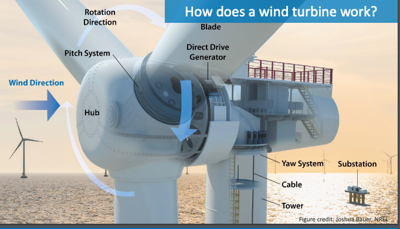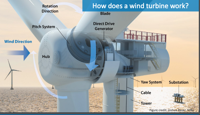The federal government is looking into the possibility of placing turbines in the waters around Guam to generate electricity for the island using offshore winds.
It’s possible a contractor could be given a lease to start analyzing any suitable offshore land as early as 2028, according to a fact sheet from the federal Bureau of Ocean Energy Management, or BOEM. After that, any actual construction would have to be approved by the bureau.
Officials from BOEM are leading the project, and were on Guam last week to meet with various representatives from other federal agencies and the government of Guam.
In a conference room at the Guam Museum on Wednesday, dozens of officials from the federal and local government were seated around a table to discuss the possibility of offshore wind energy for the island.
It was the inaugural meeting of a new intergovernmental task force BOEM created at the request of Gov. Lou Leon Guerrero.
Officials from the Guam Power Authority, Department of Land Management, and Department of Agriculture, among others, were present.
The new project is part of a mandate from the Biden administration to deploy 30 gigawatts of offshore wind energy across the U.S. by 2030, with another 15 gigawatts provided by floating wind turbines, a new technology by 2035.
Solar not enough
Offshore wind could be an option to add more renewable power generation to the grid, with solar unable to pick up the whole workload, said John Cruz, GPA assistant general manager for engineering.
GovGuam has a goal of getting the whole island to full renewable energy by 2045, but solar farms just can’t keep up during the island’s rainy season.
If the island installed enough solar to power the grid during the rainy season, “you’re probably going to end up with five times what you need when it’s not rainy,” Cruz said.
Past wind turbine attempts pitched at GPA have been too expensive to get awarded, according to Cruz, but there are higher wind speeds offshore that could make up for the difference.
However, previous analysis also shows that the rainy season also lines up with slower wind speeds in several months of the year.
Tanguisson Beach, where a former GPA power plant is already hooked into the grid, could be a good landing site for cables from the offshore turbines.
Deeper seas
New floating wind turbines could become viable for utilities-scale use by the end of the decade, and allow turbines to be placed out in deeper waters around the island, Amy Robertson with the National Renewable Energy Lab told the task force.
Unlike current turbines, which have to be fixed to the bottom of the seafloor, floating turbines are buoyed above the surface and then anchored to the bottom with cables.
According to Robertson’s presentation, that allows for turbines to be placed out of sight, farther from the coast, where winds are generally stronger.
Analysis
A “heat map” will be built that shows the most suitable offshore locations for wind turbines, with things like the slope of the ocean floor, marine life, fishing grounds, and commercial shipping lanes taken into account.
The National Oceanic and Atmospheric Administration is creating the map, taking 10-acre sections of the ocean space around Guam and assigning them suitability scores, said James Morris, NOAA spatial planning team lead.
Areas with the highest “conflict” will be put in red on the map, while those with the least will be in green.
“There generally is never a spot in the ocean that’s free of conflict, that just doesn’t exist. So what we’re really talking about is mitigating conflict and mitigating impacts on the environment,” Morris said.
A cultural study, study of marine archeological studies, and a marine habitat study are all lined up, according to Dave Pereksta, avian biologist with BOEM.
Potential impacts of the wind turbines on birds will also be taken into account, Pereksta said.
Officials from the Department of Defense will also be involved, according to the Wednesday task force meeting, to weigh in about national security interests in any area.
Concerns
Residents and officials did share some questions and concerns about the offshore wind plans moving forward.
One thing that Guam didn’t want was a separate power grid for the Department of Defense, similar to the segregated school system the military now had, said Lester Carlson, director of the local Bureau of Budget and Management Research.
“We have a monopoly in our power generation and distribution system. We’re looking at augmenting that monopoly, not creating something that is beneficial to one entity and not the rest,” he said.
Impacts on fishing were a major concern for several people.
Audrey Toves, a fisherwoman and captain of One Love Gud Vibes Charters, asked that input from those in the local fishing community be sought before the plans moved forward.
She noted that some of Guam’s prime fishing grounds up north would already be cut off for large parts of the year once the firing range at Marine Corps Base Camp Blaz is activated in November.
“I think that the community is going to have a lot of concern, just because we’re getting more and more restrictions in the fishing areas where it’s prime fishing ground,” Toves said.
Jason Biggs, with Agriculture’s Division of Aquatic and Wildlife Resources, likewise asked that all the information be shared by NOAA, and that community input be gathered before the federal government made any decision.
The Rota channel, eyed as a potential spot for turbine placement, was a hot fishing area with only about 20 miles of ocean space falling into Guam’s jurisdiction, Biggs noted.
Doug Boren, director for the BOEM Pacific region, told those present that fishers are essentially able to go right up the wind turbines and fish around them in numerous other areas.
“There’s no restriction other than you know, they could not board the facility itself,” Boren said, adding that there’s usually about 1 nautical mile between any two turbines.
Director Joe Borja from the Guam Department of Land Management said he was curious about who and how much would be paid for the leasing of offshore land.
“When we talk lease, we talk compensation. I’m sure Lester will get some information on where that compensation goes,” Borja said.
Boren said transparency is a goal as BOEM moves forward with its plans.
“Hopefully we can find areas that offshore wind may be something that could be a tool in the toolbox for the island of Guam,” he said.








(1) comment
Sorry, but get your fish from a can. I need electricity.
Welcome to the discussion.
Log In